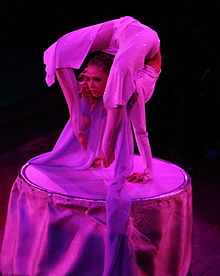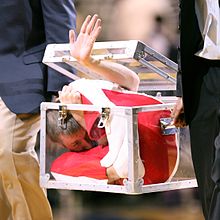

Contortion (sometimes contortionism) is a performance art in which performers called contortionists showcase their skills of extreme physical flexibility. Contortion acts often accompany acrobatics, circus acts, street performers and other live performing arts. Contortion acts are typically performed in front of a live audience. An act will showcase one or more artists performing a choreographed set of moves or poses, often to music, which require extreme flexibility. The physical flexibility required to perform such acts greatly exceeds that of the general population. It is the dramatic feats of seemingly inhuman flexibility that captivate audiences.
|
See also: Glossary |
Many factors affect the flexibility of performers including age, genetics, stature, and adherence to rigorous physical training routines. Most contortionists are generally categorized as "frontbenders" or "backbenders", depending on the direction in which their spine is most flexible. Relatively few performers are equally adept at both.
Skills performed by contortionists include:

A medical publication from 2008 suggests that long-term damage to the spine, called scoliosis, is common in long-term contortion practitioners. A study of five practitioners using magnetic resonance imaging (MRI) by Peoples et al. documented limbus vertebrae, intervertebral disc bulges, and disc degeneration. Three of the five practitioners also reported back pain.[2]

Contortion acts are highly variable; many incorporate elements of humor, drama, shock, sensuality, or a blend of styles. Contortion may be incorporated into other types of performance, such as dance and theater.
A contortionist may perform alone or may have one or two assistants, or up to four contortionists may perform together as a group.
In the past, contortionists were associated almost exclusively with circuses and fairs. More recently they have also been found performing in nightclubs, amusement parks, in magazine advertisements, at trade shows, on television variety shows, in music videos, and as warmup acts or in the background at music concerts.
The Ross Sisters were American contortionists most famous for their musical rendition of 'Solid Potato Salad' in the 1944 movie Broadway Rhythm.[4] In addition, contortion photos and digital movie clips are traded by fans on the Internet, and several web sites provide original photos of contortion acts for a monthly fee, or sell videotapes of performances through the mail.
Some loose-jointed people are able to pop a joint out of its socket without pain, thereby making it difficult to determine if a joint is dislocated without medical examination such as an X-ray. However, as long as the joint socket is the right shape, most extreme bends can be achieved without dislocating the joint.[5] Actual dislocations[6] are rarely used during athletic contortion acts since they make the joint more unstable and prone to injury, and a dislocated limb cannot lift itself or support any weight.

The primary origins of contortion take place in Asian traditions. In China and Mongolia, traditional Buddhist Cham dances would incorporate contortion into their movement. The success of these dances then encouraged the act to expand into other forms of performance. Contortion also found similarities and expressions in the Hindu doctrine of yoga. Throughout daily meditation, yoga practitioners work to assume many similar poses to those in the performance-based contortion. The recognition of these similarities in various practices and thoughts brought contortion into more clear and explicit light. For those in the Chinese tradition, contortion is typically performed as a feat of acrobatics, used to dazzle the audience with the unusual shapes built before them. According to Chinese historical records, early contortionism originated in China during Western Zhou Dynasty (1045-771 BC), which matured in Sui Dynasty (581–618).
|
See also: Glossary |


